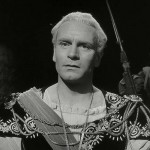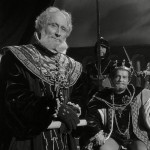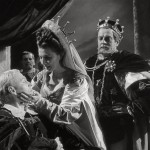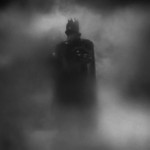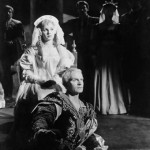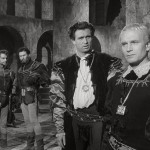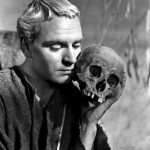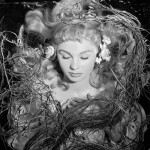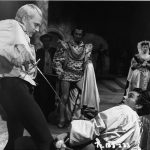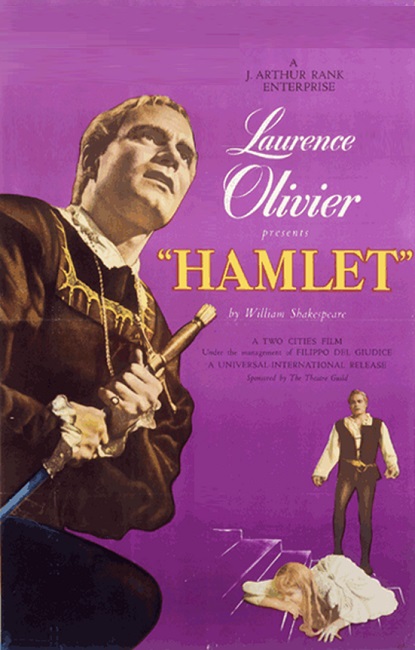
Hamlet – 1948
“To be, or not to be. That is the Question.” Or how about, “Frailty, thy name is woman.” Maybe, “There is something rotten in the state of Denmark.” Or if you prefer, “Neither a borrower nor a lender be.” Or then again, “To thine own self be true.” Or maybe even, “Get thee to a nunnery!” Or why not, “The play is the thing.” Also, though not included in this film adaptation, “What a piece of work is man?” This is Shakespeare, and I don’t know any of his other plays, comedies or tragedies, that have so many memorable quotes. Hamlet is, of course, is one of Shakespeare’s most popular plays, only being superseded, perhaps, by Romeo and Juliet. This Oscar winning version is widely considered one of the best film adaptations of the drama, largely due to the film’s adaptor, director, and leading actor, Sir Lawrence Olivier.
The basic story is one that can be summed up in a nutshell. Prince Hamlet’s father is murdered and the dead king’s ghost tells him to get revenge. However, much of the tale’s drama comes from the psychological journey that Hamlet takes in enacting that revenge. But I am not going to attempt to write a review of the plot of Shakespeare’s play. Rather, I intend to focus, as much as possible, on Olivier’s film adaptation. Keep in mind that the stage play is actually over four hours long. This film adaptation runs just over two and a half hours. Plenty of the play’s content was cut. Most noticeably, the characters of Rosencrantz, Guildenstern, and Fortinbras were completely left out.
Once again, I cannot wait until films start coming out in color. The costumes alone were probably brilliant and dazzling, but as the movie was black and white they seemed diminished, somehow. In fact, the film won an Academy Award for best Costume Design. (The Queen’s costumes were particularly fantastic!) But that being said, I recognized a specific benefit to the film being done in black and white. I think one of the film’s biggest flaws was easier to hide without color. Olivier was forty years old when performing the role. Eileen Herlie, who played Gertrude, his mother, was only twenty-eight. Despite the heavy makeup and bleach blonde hair, Olivier was obviously too old for the part. Yes, his acting was superb, but he was just not young enough to play the youthful Prince. Having the movie filmed in black and white, helped to hide that problem.
The movie’s score was composed by famous classical composer William Walton. Much of the music sounded appropriate for the period in which the story takes place. But during the dramatic moments, the score had a wonderful gravitas that seemed to emphasize the tortured psyche of Prince Hamlet, through which the plot leads us.
Other actors who stood out to me in the cast were Basil Sydney as King Claudius, Jean Simmons as Ophelia, Eileen Herlie as Gertrude, and in a very minor role as the Gravedigger, Stanley Holloway. Holloway is best known for playing Alfred P. Doolittle in 1964s My Fair Lady.
I’ve seen Hamlet on stage and I’ve seen another film adaptation – Kenneth Brannagh’s 1996 version. So I am no stranger to the plot. But one thing I never really understood was the exact nature of Ophelia’s death. I mean, yes, she lost her marbles. But then she goes out and commits suicide by drowning herself? In Olivier’s version, her demise did not seem so deliberate, and that made it more believable to me, or at least more understandable. This movie portrayed it as more of an accident than an intended suicide. Her mind was so far gone that when she decided to get in the water and lazily float along with the river, it never occurred to her to try to stay afloat when her soaked clothing pulled her under the surface. Simmons was gorgeous and played crazy well.
Another thing that I found very effective about the film was a simple, yet ingenious, special effect. It was actually very cool and did a great job of building tension. There are two scenes in which the dead King’s ghost makes an appearance. Both times, they had the fog machines going and Walton’s music was dark and mysterious. Each time, the camera was focused on the characters to which the apparition would appear. Then, the sound of something like a heart-beat began, and the camera would phase in and out of focus in time with the ominous beating. The first time it happened, I didn’t understand what was being done. But the disorienting shifts in focus along with the crescendo of the music really made for a spooky effect. Add to that the frightened expressions on the faces of the actors, and the effect accomplished its goal.
Lawrence Olivier really did a fine job, both behind and in front of the camera. Once I got over the idea that he was too old for the part, I had to admit that he really was a great actor. His emotions seemed real and believable. I especially liked the “To be, or not to be” speech. You often hear it quoted out of context, but Olivier’s delivery within the context of the play made it so much more meaningful. In fact, Olivier has been considered by many to be the greatest actor of the 20th century.
Interesting note: Olivier had been the only actor to direct himself into an Academy Award for Best Actor until 1998, when Roberto Benigni did the same with the movie Life is Beautiful. However, Benigni’s movie did not win the Academy Award for Best Picture. Ironically, it lost that honor to the movie Shakespeare In Love.
